
Lesser Poland, often known by its Polish name Małopolska, is a historical region situated in southern and south-eastern Poland. Its capital and largest city is Kraków. Throughout centuries, Lesser Poland developed a separate culture featuring diverse architecture, folk costumes, dances, cuisine, traditions and a rare Lesser Polish dialect. The region is rich in historical landmarks, monuments, castles, natural scenery and UNESCO World Heritage Sites.
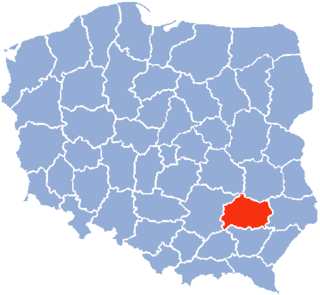
The Tarnobrzeg Voivodeship was a unit of administrative division and local government in Poland in years 1975-1998, superseded in parts by Subcarpathian Voivodeship, Świętokrzyskie Voivodeship and Lublin Voivodeship. Its capital city was Tarnobrzeg, although the major city in the region was Stalowa Wola.

Sandomierz is a historic town in south-eastern Poland with 23,863 inhabitants, situated on the Vistula River near its confluence with the San, in the Sandomierz Basin. It has been part of Świętokrzyskie Voivodeship since its transfer from the Tarnobrzeg Voivodeship in 1999. It is the capital of Sandomierz County. Sandomierz is known for its preserved Old Town, a major cultural and tourist attraction which the President of Poland declared a National Monument of Poland in 2017.

Stalowa Wola is the largest city and capital of Stalowa Wola County with a population of 58,545 inhabitants, as at 31 December 2021. It is located in southeastern Poland in the Subcarpathian Voivodeship. The city lies in historic Lesser Poland near the confluence of the Vistula and the San rivers, and covers an area of 82.5 km2 (31.9 sq mi). Stalowa Wola is one of the youngest cities of Poland. It was built from scratch in the late 1930s in the forests surrounding village of Pławo. The city was designed to be a settlement for workers of Huta Stalowa Wola, a plant built as part of the Central Industrial Region. The name "Stalowa Wola" translates to "Steel Will" in English, reflecting its origins and purpose as a city established to support the steel industry. Stalowa Wola is home to the sports club Stal Stalowa Wola.

Pinsk is a city in Brest Region, Belarus. It serves as the administrative center of Pinsk District, though it is administratively separated from the district. It is located in the historical region of Polesia, at the confluence of the Pina River and the Pripyat River. The region was known as the Pinsk Marshes and is southwest of Minsk. As of 2023, it has a population of 124,613.

The Adam Mickiewicz University is a research university in Poznań, Poland.

Sandomierz Voivodeship was a unit of administration and local government in Poland from the 14th century to the partitions of Poland in 1772–1795. It was part of the Lesser Poland region and the Lesser Poland Province. Originally Sandomierz Voivodeship also covered the area around Lublin, but in 1474 its three eastern counties were organized into Lublin Voivodeship. In the 16th century, it had 374 parishes, 100 towns and 2586 villages. The voivodeship was based on the Sandomerz ziemia, which earlier was the Duchy of Sandomierz. The Duchy of Sandomierz was created in 1138 by King Bolesław III Wrymouth, who in his testament divided Poland into five principalities. One of them, with the capital at Sandomierz, was assigned to Krzywousty's son, Henry of Sandomierz. Later on, with southern part of the Seniorate Province, the Duchy of Sandomierz created Lesser Poland, divided into Kraków and Sandomierz Voivodeships.

Raków is a village in Kielce County, Świętokrzyskie Voivodeship, in south-central Poland. It is the seat of the gmina called Gmina Raków. It lies in historic Lesser Poland, approximately 39 km (24 mi) south-east of the regional capital Kielce.

The Collegium Hosianum was the Jesuit collegium founded in 1565, 1566 by Polish Cardinal Stanislaus Hosius in Braunsberg (Braniewo), Kingdom of Poland. The town was then part of the Polish Prince-Bishopric of Warmia under rule of Cardinal Hosius. The Collegium Hosianum was one of the biggest Jesuit schools and one of the most important centres of Counter-Reformation in Europe and was particularly established to educate Catholic clergy of different countries.

Krzyżtopór is a castle located in the village of Ujazd, Iwaniska commune, Opatów County, Świętokrzyskie Voivodeship, in southern Poland. It was originally built by a Polish nobleman and Voivode of Sandomierz, Krzysztof Ossoliński (1587–1645). The castle was partially destroyed during the Swedish invasion known as The Deluge in 1655, and then reduced to ruins during the war of the Bar Confederation by the Russians in 1770.
Kraków Governorate was an administrative-territorial unit (guberniya) of Congress Poland of the Russian Empire.
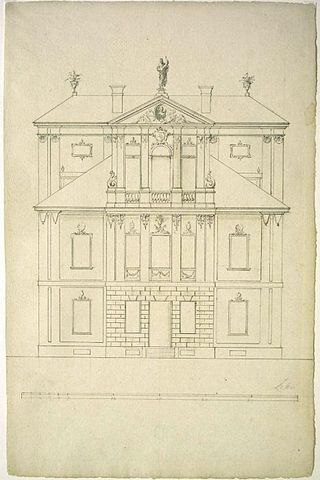
The Kotowski Palace was a 17th-century palace in Warsaw, Poland. It served as the main cloister building for the Benedictine Sisters of Perpetual Adoration.

The Diocese of Sandomierz is a Latin diocese of the Catholic Church located in the city of Sandomierz in the ecclesiastical province of Lublin in Poland.
Pęcławice Górne is a village in Gmina Bogoria, Staszów County, Świętokrzyskie Voivodeship in south-central Poland. It is about 5 kilometres (3 mi) east of Bogoria, 15 km (9 mi) north-east of Staszów and 57 km (35 mi) south-east of the regional capital, Kielce. In 2009, the village population had fallen to 108.

The Sandomierz Royal Castle is a medieval structure in Sandomierz, Poland. It was built on a slope of Vistula River by Casimir III the Great and extended in the 16th century. The original building was blown up in 1656, leaving only the west wing standing. It was later transformed into a Renaissance styled residence with the west wing preserved as a museum.
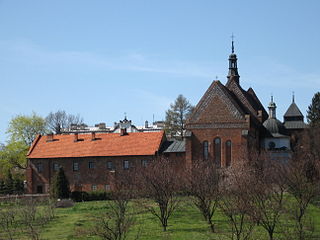
The Church of St. James in Sandomierz, also known as the Shrine of Blessed Sadok and 48 Dominican martyrs, Monastery of Dominicans, Shrine of Our Lady of the Rosary, is one of the oldest brick churches in Poland and the second oldest Dominican monastery in Poland. This church is a unique indirect form of Romano-Gothic style. The Roman ceramic decorations on the outside gabled walls are unusual and beautifully done. The stained glass windows inside are particularly beautiful, and date from 1910 to 1918.
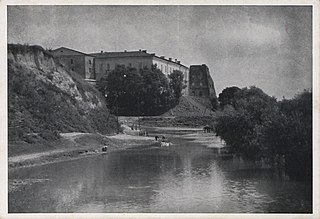
Klevan Castle is one of the oldest forts in Volynia, Ukraine. It was built in the mid-15th century by Prince Michael Czartoryski in order to control a ford over the Stubla River. Klevan was the main seat of the Orthodox princely house of Chortoryisk until its members converted to Catholicism in the 17th century. After that the castle was given to a Jesuit school. After the partitions of Poland the castle was confiscated by the Habsburgs, and stood untenanted. Its western wall was pulled down in the 19th century. The remaining portions include two towers, three fortified buildings, and a high four-arched bridge leading to the main gate.
The Second Battle of Opatów, one of many clashes of the January Uprising, took place on 21 February 1864 near the town of Opatów, which at that time belonged to Russian-controlled Congress Poland. A party of some 1,000 Polish insurgents, commanded by Ludwik Zwierzdowski and Apolinary Kurowski, tried to capture the town, which was defended by an 800-strong garrison of the Imperial Russian Army. The battle ended in Russian victory; Russian losses were estimated at app. 50 killed, while Poles lost 50 killed and 62 wounded.
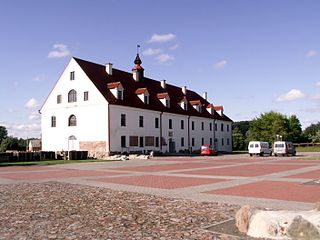
The Kražiai College was a Jesuit college in Kražiai, Grand Duchy of Lithuania and later Russian Empire. Established in 1616 in hopes to educate new generations of anti-Protestants, the college was one of the major cultural and educational centers in Samogitia. In 1620–1742, it shared premises with the Samogitian Priest Seminary. In 1844, the college was transferred to Kaunas.

















